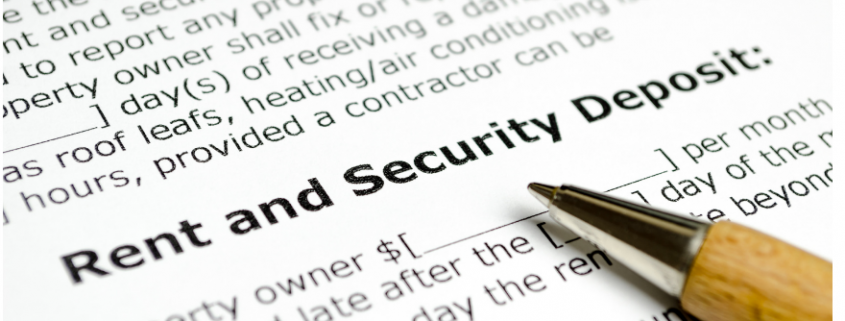There are often questions asked about how much a landlord is legally allowed to charge for a Damage Deposit or Pet Deposit. If you have further questions or feel you are being charged too much for your Pet or Damage Deposit, please give us a call to speak to one of our expert legal advocates at 250-493-6822 or email at support@accesscentre.org
The Basics
A security deposit – often referred to as a “damage deposit” – secures the tenancy for you and your landlord. Once you have paid your deposit, you cannot decide to move in somewhere else, and your landlord cannot decide to rent to someone else. If you pay a security deposit but do not move in, your landlord may be allowed to keep your deposit. You may even have to pay additional money to cover the cost associated with re-renting your unit, or to cover your landlord’s lost rental income if they cannot find a replacement tenant.
Security Deposits
According to section 19(1) of the Residential Tenancy Act, the maximum amount a landlord can charge for a security deposit is half the monthly rent. If your landlord requires a security deposit, you must pay it within 30 days of the date it is required to be paid. If your landlord believes you are responsible for damage beyond reasonable wear and tear, they can ask the Residential Tenancy Branch for permission to keep your security deposit.
Pet Damage Deposits
If you are allowed to have a pet, your landlord can require a pet damage deposit of up to half the monthly rent. This is the maximum amount a landlord can charge for a pet damage deposit, regardless of how many pets you have. You will have to pay this deposit either at the start of your tenancy, or when you get a pet at any point during your tenancy. If your pet causes extraordinary damage or unreasonably disturbs others, your landlord may try to evict you and keep your pet damage deposit. See TRAC’s webpage, Pets, and Residential Tenancy Branch Policy Guideline 31 for more information.
Guide dogs: If you have a dog that falls under the Guide Dog and Service Dog Act, your landlord must allow it and cannot require a pet damage deposit.
Applying Deposits Towards Rent: According to section 21 of the Residential Tenancy Act, you are not allowed to apply your security deposit towards rent without your landlord’s permission. For example, you cannot pay only half of your last month’s rent and tell your landlord to cover the remaining half with your security deposit, unless you have their written consent.
Overpaying a Deposit: The maximum amount you can be charged for a security deposit or pet damage deposit is half the monthly rent. If you have been overcharged for either, section 19(2) of the Residential Tenancy Act allows you to deduct the overpayment from your next month’s rent. Some landlords may not know that tenants have this right, so make sure to clearly communicate with your landlord if you decide to deduct rent for this reason. See TRAC’s template letter, Withholding Overpayment of Deposit from Rent. If you are not comfortable withholding rent, you can apply for dispute resolution to recover the overpayment.
Getting Your Deposit Returned: If you would like to have your deposit returned, the first step is to provide your landlord with a forwarding address in writing indicating where your deposit can be sent. See TRAC’s template letter, Return of Security / Pet Damage Deposit. Make sure to have evidence that you provided your forwarding address, such as a witness or registered mail confirmation. You should also have the option to list your forwarding address on the move-out condition inspection report.
Once you have provided your forwarding address in writing and your tenancy has officially ended, your landlord has 15 days to take one of the following three actions:
- return your deposit;
- get your written permission to keep some or all of your deposit; or
- apply for dispute resolution to keep some or all of your deposit.
Your landlord can return your deposit by delivering it in person, mailing it, leaving it in your mailbox or mail slot, or sending it electronically. If your landlord returns your deposit by electronic means, they are not allowed to charge a fee.
Your landlord cannot simply decide on their own to keep your deposit. If they want it, they need written permission from either you or the Residential Tenancy Branch. After 15 days, if your landlord has not returned your deposit, obtained your written consent, or applied for dispute resolution, section 38 of the Residential Tenancy Act (RTA) gives you the right to go after your landlord through dispute resolution for double the amount of your deposit.
Condition inspection reports: If your landlord does not give you a chance to participate in a move-in or move-out condition inspection, or does not provide you with a copy of either report within the required timelines, they lose the right to claim against your security or pet damage deposit for damage to the rental unit. Conversely, if you fail to participate in an inspection after receiving two opportunities, you may lose the right to have your deposit(s) returned. See sections 24 and 36 of the RTA for more information.
Info from Deposits – TRAC (tenants.bc.ca)




 Becca Tapert
Becca Tapert